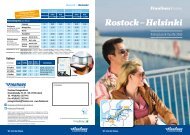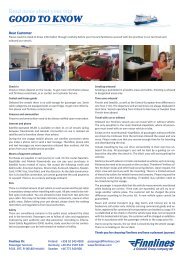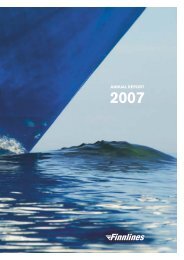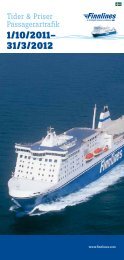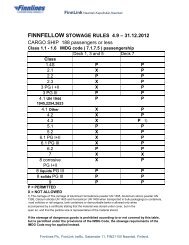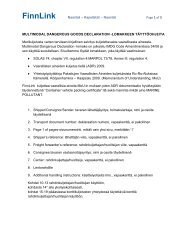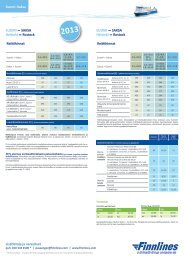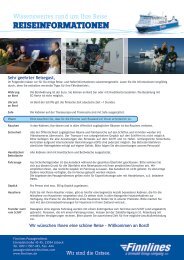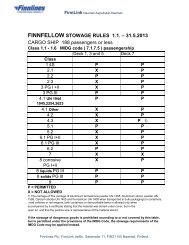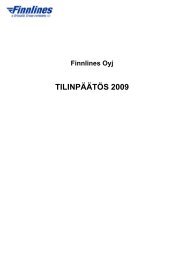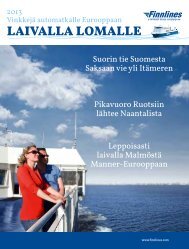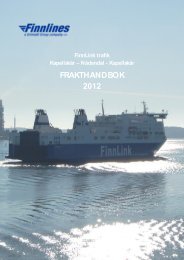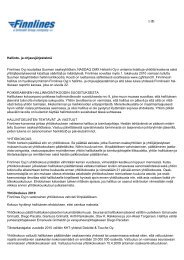FINANCIAL STATEMENTS 2010 - Finnlines
FINANCIAL STATEMENTS 2010 - Finnlines
FINANCIAL STATEMENTS 2010 - Finnlines
You also want an ePaper? Increase the reach of your titles
YUMPU automatically turns print PDFs into web optimized ePapers that Google loves.
transaction is no longer expected to occur, the cumulative gain or<br />
loss that was deferred in shareholders' equity is recognised im-<br />
mediately in the profit and loss account.<br />
Even though some hedging relationships may fulfil the require-<br />
ments set by the Group's risk management on effective hedging,<br />
hedge accounting in accordance with IAS 39 is not applied to<br />
them. Such instruments include any derivatives hedging against<br />
foreign currency risk related to operations, and interest rate<br />
derivatives hedging against interest rate risk of debt portfolio,<br />
whose fair value changes are recognised in financial income and<br />
expenses. In the statement of financial position these items are<br />
shown, according to their nature, under either short- or long-term<br />
receivables or payables.<br />
LEASES<br />
The Group as a lessee<br />
Leases with the Group as leaseholder, where a significant pro-<br />
portion of the risks and benefits associated with ownership re-<br />
main with the lessor, are classified as operating leases, and the<br />
leases paid in relation to them are recognised as expenses in the<br />
profit and loss account on a straight-line basis over the period of<br />
the lease.<br />
Leases in which the company has assumed a significant pro-<br />
portion of the risks and benefits associated with ownership are<br />
classified as finance leases. Finance leases are recognised on<br />
the statement of financial position as assets and liabilities on the<br />
start date of the lease period at a value equivalent to the lower<br />
of the fair value of the leased goods or the present value of the<br />
minimum lease, which are determined on the date of contract.<br />
Minimum leases are divided into financial expenses and loan re-<br />
payments. Financial expenses are recognised as expenses in the<br />
profit and loss account and allocated over the reporting periods<br />
within the lease contract period to the extent that the outstand-<br />
ing loan in each period has an equal interest rate. Depreciation of<br />
the leased assets subject to depreciation is calculated accord-<br />
ing to the same principles as depreciation of owned assets. If<br />
there is relative certainty that the Group will receive ownership of<br />
an asset before the end of its lease period, the asset’s estimated<br />
useful life is the same as its economic life. Otherwise, the asset<br />
is depreciated within the shorter of the lease period or the useful<br />
life.<br />
The Group as a lessor<br />
Leases where the Group retains substantially all the risks and<br />
benefits of ownership of the asset are classified as operating<br />
leases. Leases where the group acts as a lessee of vessels un-<br />
der operating leases but where the Group generates income<br />
through subleasing these, are also classified as operating leases.<br />
Lease income from operating leases is recognised in income on<br />
a straight-line basis over the lease term, and in case of vessels,<br />
normally adjusted with the non-usable days for the lessee.<br />
INVENTORIES<br />
Inventories include the fuel, lubricant, bulk and food supplies of<br />
16 FINNLINES PLC Financial Statements <strong>2010</strong> (figures in EUR thousand, if not stated otherwise)<br />
the Group's vessels, as well as goods for sale on the vessels. In-<br />
ventories are valued at the lower of their acquisition cost or their<br />
net realisation value. Acquisition costs are determined using the<br />
FIFO (first in, first out) method. The net realisation value is the es-<br />
timated sale price in ordinary business transactions, from which<br />
the cost of sale has been deducted.<br />
EQUITY<br />
Instruments issued by the Group, which do not contain contrac-<br />
tual obligation to transfer cash or financial assets or to exchange<br />
financial assets or financial liabilities with other entities under po-<br />
tentially unfavourable terms, and which evidence a residual inter-<br />
est in the assets of the Group after deducting all of its liabilities,<br />
are classified as equity. The share capital consists of ordinary<br />
shares.<br />
Costs arising from issues or acquisitions of equity instru-<br />
ments are accounted for as a deduction from equity. If the Group<br />
reacquires its own equity instruments, those instruments are<br />
deducted from equity.<br />
INCOME TAXES<br />
The tax expenses recognised on the profit and loss account con-<br />
sist of income tax payable on taxable profit and of deferred taxes.<br />
Income tax on taxable profit for the reporting period is calculat-<br />
ed using the valid tax rate of each country. Taxes are adjusted by<br />
possible taxes relating to previous periods.<br />
Deferred tax liabilities are calculated using the statement of<br />
financial position liability method, by calculating the tax from all<br />
temporary differences between book value and taxable value.<br />
Deferred taxes are calculated using the tax rates valid on the end<br />
of the reporting period.<br />
Deferred tax assets are recognised in the accounts up to the<br />
amount at which it is likely that taxable income will be generat-<br />
ed in the future, against which the tax receivables can be used.<br />
No deferred taxes are recognised for subsidiaries' undistributed<br />
earnings.<br />
EMPLOYEE BENEFITS<br />
Pension liabilities<br />
The Group has various pension plans in accordance with the lo-<br />
cal regulations of each country in which it operates. Group's pen-<br />
sion plans are classified as defined contribution plans and de-<br />
fined benefit plans.<br />
Employee pension plans are organised through external pen-<br />
sion insurance companies. The Finnish TyEL pension insurance<br />
organised through external pension insurance companies is<br />
treated as defined contribution plans as of 1 January 2006.<br />
In defined contribution plans, the company makes fixed pay-<br />
ments into the plan. The company has no legal or actual obliga-<br />
tion to make additional payments if the pension insurance com-<br />
pany is unable to pay out the benefits earned by employees in the<br />
current period or in previous periods. Payments made into de-<br />
fined contribution plans are recognised in the profit and loss ac-<br />
count in the reporting period to which the payment applies.



